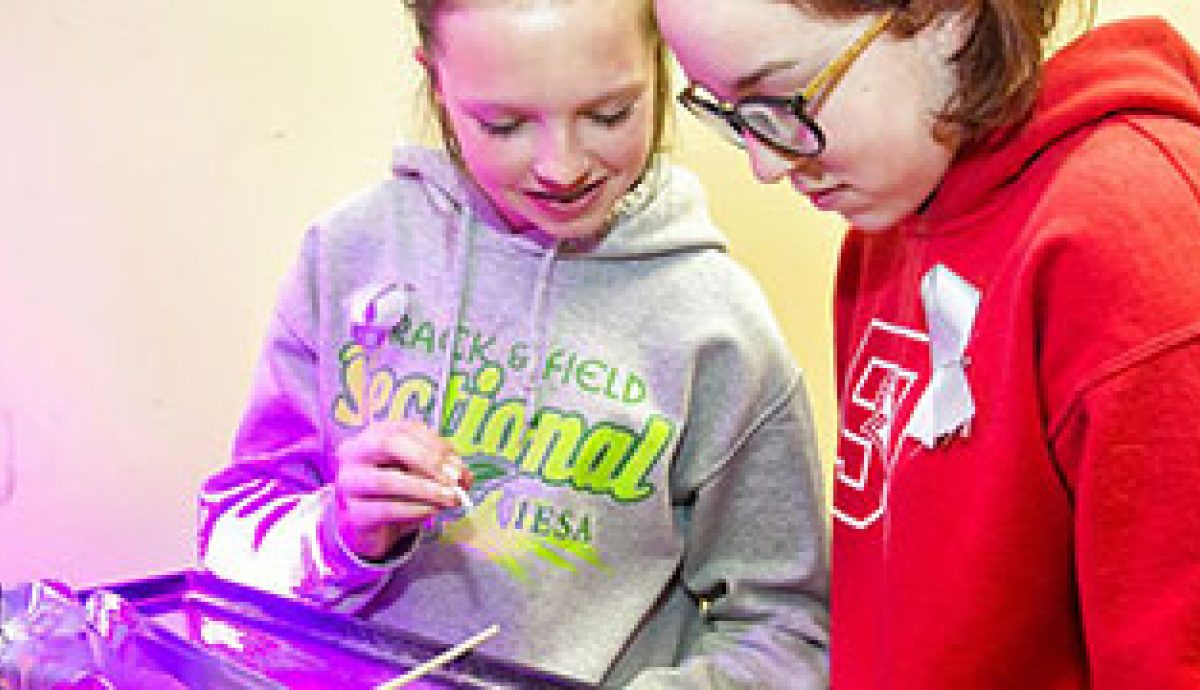Successful Project Based Learning Curriculum Using Purple Plow
Marian Handlin, M.Ed. is an AgriScience teacher from Delaware. She writes about how her school successfully implemented Purple Plow Challenges into their STEM curriculum.

We interviewed Marian Handlin from Alfred G. Waters Middle School in Delaware about using Purple Plow in her curriculum.
Q. Why did you pick the Purple Plow?
A. Last school year, I was given the go ahead to revamp the middle school agriculture curriculum for our school. I was encouraged to include hands-on activities and PBL (project based learning).I attended the National Ag. in the Classroom conference in June 2019 with the hopes of learning some hands-on activities for my classes.While participating in the excellent workshops there, I learned about Purple Plow challenges and puzzlers.It was one of the most beneficial professional development events I’ve ever attended in my 17 years of teaching. I knew right away that Purple Plow was the perfect platform and content for my new curriculum design.
Q. How are you using the Purple Plow in your school?
A. My entire curriculum is based around Purple plow challenges and puzzlers. I include field trips, guest speakers, FFA content, and school specific lessons on Fridays and/or after the three units are complete. We are a 1:1 school with iPads. For all my classes, I create assignments in Schoology for each step in the Engineering Design Process. When the group completes the step (both challenges and puzzlers), the group submits evidence of completion to the assignment in Schoology (formative grade). When groups (all grades) share the presentations, they are graded against the “Purple Plow Challenges Rubric” (summative grade). I put point values of 12, 15, 17, and 20 to the columns of the rubric. These values make it so that as long as the group completes their presentation, they will earn a grade of at least 60% (which is considered passing at our school).
My 8th grade students complete at least three challenges in the one marking period I teach them. They look at all created challenges and, as a class, choose challenges based on the given criteria. I offer one challenge per agricultural pathway offered by the high schools in our school district, which are Animal Science, Plant Science, and Environmental Science and Natural Resources. Students have only two weeks (four days per week, 40 minute classes) to work through the challenge (see table below). If time allows another challenge/material, it is “teacher’s choice.”
The materials list must be submitted by the third day (and be all Amazon Prime items with delivery of two days or less) in order for the items to arrive on time for the “create” step the following week. I print the “Student Guide” for the current challenge and grade it on completion (formative grade).
My 6th and 7th graders complete at least six puzzlers in the one marking period I teach them. They look at all available puzzlers and as a class (two classes per grade) choose puzzlers based on given criteria (one puzzler per agricultural pathway offered by the high schools in our school district). If time allows more puzzlers/material, they are “teacher’s choice.”
6th grade
- Plant Science: 10, 11, 16, 17, 26
- Animal Science: 12, 19, 21, 25
- Environmental / Natural Resources: 1, 4, 5, 6, 13, 14, 15
- Teachers choice: 22, 23
7th grade
- Plant Science: 2, 3, 7, 8, 9,
- Animal Science: 18, 20, 28, 29
- Environmental / Natural Resources: 27, 31, 32, 33, 34, 35, 36, 37, 38, 39, 40
- Teachers choice: 24, 30
Time Line:
Environmental / Natural Resources:
Unit 1: Puzzler 1 (first class’ choice) – 1st week, Puzzler 2 (2nd class’ choice) – 2nd week
Unit 2: Puzzler 1 (first class’ choice) – 1st week, Puzzler 2 (2nd class’ choice) – 2nd week
Unit 3: Puzzler 1 (first class’ choice) – 1st week, Puzzler 2 (2nd class’ choice) – 2nd week
Q. Would you recommend it to other schools? If yes do you have any suggestions for them.
A. I piloted the new curriculum map first marking period and it was a huge success. My weekly walkthroughs from my administrators were excellent, student engagement was high, and collaboration was happening. We even had family involvement! My supervisor asked me to pitch it to the other two middle schools in our school district to make it the district-wide curriculum so we could be horizontally aligned. I shared it with the other two schools during a professional development day. My coworkers were very pleased with the layout and we worked together to come up with which puzzlers would be for which grades. If there are any new middle school Ag. teachers, or anyone looking to add hands-on/PBL lessons, they should definitely consider adding challenges and puzzlers.
Q. How/why do you think others might benefit from using it?
A. It made it much simpler for us to know what we were teaching every day and for the students to know what came next. My evaluator was looking for me to have a set routine each week, so I stretched each puzzler from the set 1-2 hours to four forty-minute classes by adding the requirements from the challenges.
It also helped us on our official evaluations because the students determine the curriculum. The way we set it up allows for flexibility on Fridays and after week six. There are many ways to incorporate them. It also lets you include more during the “teacher choice part.” For example, I was contacted by two different university affiliated groups asking for me to implement specific material for their research projects. It was easy for me to add it in during the “teacher choice” time by setting up the content in the challenge format with which students were already familiar.
Q.What do your students think of the projects? Do you have any specific stories you can share of discovery or insight?
A.Prior to this school year, if you were to ask my students how they felt about my class, you might hear the word “boring” mentioned. Since integrating Purple Plow Puzzlers and Challenges into the curriculum, the words change to “fun,” “decent,” and “interesting.” Students have enjoyed the challenges and puzzlers so much that they are choosing to work on them at home with their family. During the H2Grow challenge, a student worked with her stepdad to improve the group’s design. When working on the Farm to Food Truck challenge, I heard students talking about cuisines eaten by their families. During the Bee-ing in the Kitchen puzzler, students baked at home with their families. While working on the Edible Soil Profile puzzler, some students chose to bring their favorite food items from home to represent the various layers. Students with food allergies were able to participate by swapping other foods for their allergens. The students enjoy choosing their curriculum, working in groups, and talking through their learning. The students converse about the puzzlers and challenges outside of class time! I love seeing the excitement and inclusion of the family.
Q. What was their favorite project?
A.Of the four classes I’ve taught, I’ve experienced four different challenges: H2Grow, Cattle Ranch Riddle, Farm to Food Truck and Protect the Pollinators. I polled my current two classes (who’ve experienced H2Grow and Farm to Food Truck). One class I polled liked H2Grow the best. They enjoyed learning about the entire system and manipulating the materials to construct the final working product. The other class liked Farm to Food Truck the best because of the room for creativity.
My 6th and 7th graders have loved almost every puzzler experienced to date. Students have loved Roots Rule, Cardboard Tractor, Egg Carrier, Edible Soil Profile, Bee-ing in the Kitchen, Mini Aquaponic System, Mason Bee Hotel, Rube Goldberg Machine, Vertical Garden, and My Cafeteria Menu. They enjoyed building physical products, working together, problem solving, and tasting the product when applicable. Some students involved their family by working on the product a little bit at home and/or baking the item at home. They enjoyed the guest speaker (our school nutrition manager) who helped them work through how the menu is planned at our school during the “My Cafeteria Menu” puzzler.
Q. Anything else you want to add?
A. I’m hoping Purple Plow will add more puzzlers and challenges, especially ones about animal science, GMOs, and conventional vs organic. It would also be great to have options covering Ag. Mechanics and Structures topics (engines, electrical, plumbing, etc.). I’d encourage all middle school Ag. teachers to go to a workshop about Purple Plow or at least look at the website for puzzlers and challenges. Don’t let the timeline on there scare you! Tailor them to fit your schedule and needs.









